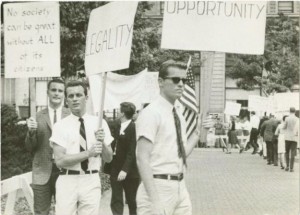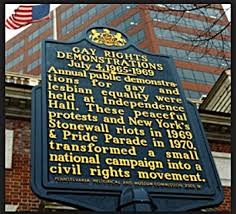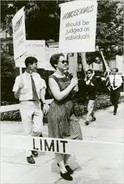Annual Reminders Historical Marker (Gay Pioneers Historical Marker)
Introduction
Text-to-speech Audio
Images
Philadelphia's first Reminder by Kay Tobin Lahusen, courtesy of New York Public Library (reproduced under Fair Use)

The historical marker honoring the Annual Reminders protest is located on Chesnut St outside of the Wells Fargo branch office. Courtesy of Philly Gay Pride (reproduced under Fair Use).

Barbara Gittings at a Philadelphia Reminder by Kay Tobin Lahusen, courtesy of New York Public Library (reproduced under Fair Use)

Frank Kameny by Simon Bruty, courtesy of The Washingtonian (reproduced under Fair Use)

Backstory and Context
Text-to-speech Audio
In the early years of the gay rights movement, committed LGBT activists from the Washington, DC and New York City chapters of the Mattachine Society, Philadelphia’s Janus Society and the New York chapter of the Daughters of Bilitus coordinated their efforts and held protests. The activists gathered at the White House in April 1965 to demand equal rights for LGBT citizens. Together, the groups operated as the East Coast Homophile Organizations (ECHO). The organizer of the White House picket was Frank Kameny, who would come to be regarded as one of the most significant figures in the early years of the LGBT movement.
Inspired by the Washington, DC pickets, activist Craig Rodwell conceived an idea for a similar event in Philadelphia. Led by Kameny and local activist Barbara Gittings, the Philadelphia event was planned for just three months later, in July of 1965. Kameny insisted that picketers follow a strict dress code of jackets and ties for men and dresses for women. The move angered some LGBT supporters but Kameny wanted to project an image of homosexuals as “presentable and employable” in hopes of winning more supporters.
The choice of Independence Hall for the event was a calculated one. It was important to Kameny and other activists to highlight the fact that they were simply demanding the basic individual freedoms enshrined in the Declaration of Independence. Thirty-nine people picketed, carrying placards demanding equal treatment under the law. At the time, it was the largest known demonstration for homosexual rights in the United States.
The event, which came to be known as the Annual Reminder, took place every July 4th in Philadelphia until 1969. The final reminder event took place on July 4 of that year, just days after the Stonewall Riots in New York City, an event that led organizers to conclude that the course of homosexual activism was permanently changed. After 1969, Reminders were gradually replaced with pride parades, most of which are held in June, on or near the anniversary of the Stonewall Riots.
The marker that commemorates the Reminders was placed in 2005 by the Pennsylvania Historical and Museum Commission. In 2015, a number of events, including a reenactment, were held to recognize the fiftieth anniversary of the first Reminder.
Sources
Noland, Alaina. Reminder Days. Encyclopedia of Greater Philadelphia. . Accessed February 04, 2019. https://philadelphiaencyclopedia.org/archive/reminder-days/.
Spikol, Liz. How Philadelphia Helped Give Birth to the LGBT Rights Movement. Philly Mag. June 28, 2015. Accessed February 04, 2019. https://www.phillymag.com/g-philly/2015/06/28/annual-reminder-lgbt-philadelphia/.
Stein, Perry. Pride's Raucous Parades Began as Suit-and-Tie Protests Called "Annual Reminders". Washington Post. June 10, 2017. Accessed February 04, 2019.
https://digitalcollections.nypl.org/items/510d47e3-b69d-a3d9-e040-e00a18064a99
http://www.phillygaypride.org/philly-pride-celebrate-50th-anniversary-independence-hall-1964-lgbt-picket/
https://digitalcollections.nypl.org/items/510d47e3-b6a9-a3d9-e040-e00a18064a99
https://www.washingtonian.com/2010/10/04/frank-kameny-the-accidental-activist/
